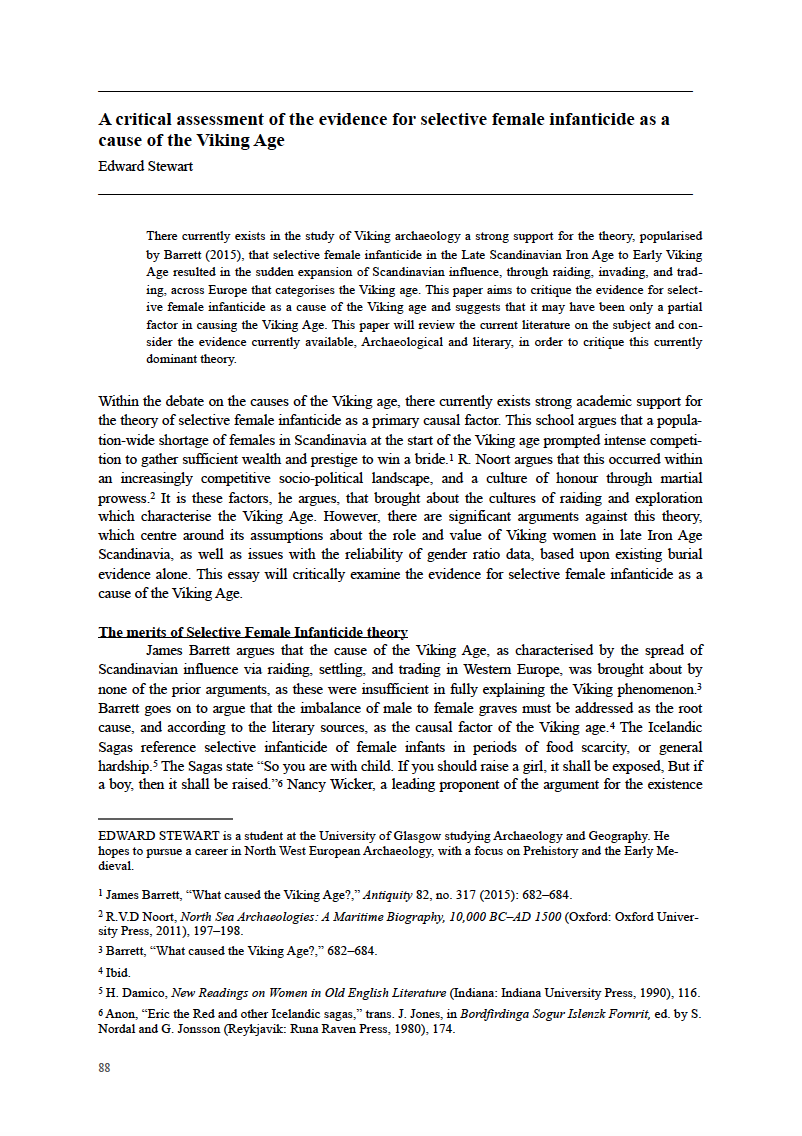A critical assessment of the evidence for selective female infanticide as a cause of the Viking Age
DOI:
https://doi.org/10.36399/GroundingsUG.11.183Keywords:
Viking, Female Infanticide, Selective, NorwayAbstract
There currently exists in the study of Viking archaeology a strong support for the theory, popularised by Barrett (2015), that selective female infanticide in the Late Scandinavian Iron Age to Early Viking Age resulted in the sudden expansion of Scandinavian influence, through raiding, invading, and trading, across Europe that categorises the Viking age. This paper aims to critique the evidence for selective female infanticide as a cause of the Viking age and suggests that it may have been only a partial factor in causing the Viking Age. This paper will review the current literature on the subject and consider the evidence currently available, Archaeological and literary, in order to critique this currently dominant theory.
References
Anon. “Eric the Red and other Icelandic sagas.” Translated by J. Jones. In Bordfirdinga Sogur Islenzk Fornrit, edited by S. Nordal and G. Jonsson, 171–217. Reykjavik: Runa Raven Press, 1980.
Anon. Annals of Ulster to A.D 1131. Translated by S.M. Airt and G.M. Niocall, 227. Dublin: Dublin Institute of Advanced Studies, 1983.
Anon. The Saga of the Volsungs: The Norse Epic of Sigurd the Dragon Slayer. Translated by L. Jesse. London, Penguin Books, 1990.
Anon. The War of the Gaehdil with the Gaill or the Invasions of Ireland by the Danes and Other Norsemen. Translated by J.H. Todd. London: Reader and Dyre, 1867.
Arrheniüs, B. “Women and gold: on the role of women in society at the time of the Great Migrations and their relationship to the production and distribution of ornaments.” In Produksjon ogsamfunn, edited by H. Resi, 85–96. Oslo: Universitetets Oldsaksamling, 1995.
Barrett, James. “What caused the Viking Age?” Antiquity 82, no. 317 (2015): 671–685.
Brettell, C.B. “Theorizing migration in anthropology: the social construction of networks, identities, communities, and globalscapes.” In Migration Theory: Talking across disciplines, edited by C.B. Brettell and J.F. Hollifield, 97–136. London: Routledge, 2000.
Ciggar, K. “Harald Hardrada: his expedition against the Pechenegs.” Balkan Studies 15, no. 1 (1980): 385–401.
Clover, C. “The politics of scarcity: Notes on the sex ratio in early Scandinavia.” Scandinavian Studies 60, no. 2 (1988): 147–188.
Damico, H. New Readings on Women in Old English Literature. Indiana: Indiana University Press, 1990.
Dommanes, L.H. “Late Iron Age in Western Norway. Female Roles and Ranks as Deduced from an Analysis of Burial Customs.” Norwegian Archaeological review 15, no. 1 (1982): 70–84.
Dommanes, L.H. “Women and Death in Old Norse Societies: an Archaeological Perspective.” In Women, Pain, and Death: Rituals and Everyday Life on the Margins of Europe and Beyond, edited by J.E. Haeland, 21–45. Indiana: Indiana University Press, 2014.
Eriksen, M.H. “Don’t all mothers love their children? Deposited infants as animate objects in the Scandinavian Iron Age.” World Archaeology 49, no. 3 (2017): 338–356.
Graham-Campbell, J. “National and regional identities: the ‘glittering prizes.’” In Pattern and Purpose in Insular Art, edited by M. Redknap et al., 27–38. Oxford: Oxbow Books, 2001.
Harrison, Stephen. “‘Warrior graves?’ the weapon burial rite in Viking Age Britain and Ireland.” In Maritime societies of the Viking and medieval world, edited by James H. Barrett and Sarah Jane Gibbon, 299–319. Leeds: Maney Publishing, 2015.
Hedenstierna-Jonson, C. and A Kjellström et al. “A female Viking warrior confirmed by genomics.” American Journal of Physical Anthropology 164, no. 4 (2017): 45–57. DOI: 10.1002/ajpa.23308.
Heinrich J., et al. “The Puzzle of monogamous marriage.” Philosophical Transactions of the Royal Society 367, no. 1 (2012): 657–669.
Holck, P. “The Oseberg Ship Burial, Norway: New Thoughts On the Skeletons From the Grave Mound.” European Journal of Archaeology 9, no. 2 (2015): 185–210.
Holcomb, K.M. “Pulling the Strings: The Influential Power of Women in Viking Age Iceland.” Student Theses Papers 45 (2015): 1–25. http://digitalcommons.wou.edu/his.
Jesch, J. The Viking Diaspora. London: Routledge, 2015.
Jesch, J. Women in the Viking Age. Suffolk: Boydell & Brewer, 2005.
Karras, R.M. “Concubinage and Slavery in the Viking Age.” Scandinavian Studies 62, no. 2 (1990): 141–162.
McGuire, E.H. “Manifestations of identity in burial: Evidence from Viking-Age graves in the North Atlantic diaspora.” PhD diss., University of Glasgow, 2009.
Noort, R.V.D. North Sea Archaeologies: A Maritime Biography, 10,000 BC –AD 1500. Oxford: Oxford University Press, 2011.
Pyburn, A.K. Ungendering Civilisation. London: Routledge, 2004.
Raffield, B., et al. “Male-biased operational sex ratios and the Viking phenomenon: an evolutionary anthropological perspective on Late Iron Age Scandinavian raiding.” Evolution and Human Behavior 38, no. 1 (2016): 315–324.
Spatacean, Cristina. “Women in the Viking age. Death, life after death and burial customs.” Masters diss., University of Oslo, 2006.
Vaupel, J.W. et al. “The Impact of Heterogeneity in Individual Frailty on the Dynamics of Mortality.” Demography 16, no. 3 (1979): 439–445.
Wicker, Nancy. “Selective Female Infanticide as Partial Explanation for the Dearth of Women in Viking Age Scandinavia.” In Violence and Society in the Early Medieval West, edited by G. Halsall, 205–221. Woodbridge: Boydell Press, 1998.
Wicker, Nancy. “Christianization, Female Infanticide, and the Abundance of Female Burials at Viking Age Birka in Sweden.” Journal of the History of Sexuality 21, no. 2 (2012): 245–262.

Published
Issue
Section
License
Copyright (c) 2018 Edward Stewart

This work is licensed under a Creative Commons Attribution 4.0 International License.
The CC BY 4.0 license is a Creative Commons license. This is a non-copyleft free license that is good for art and entertainment works, and educational works. It is compatible with all versions of the GNU GPL; however, like all CC licenses, it should not be used on software. People are free to: Share — copy and redistribute the material in any medium or format; Adapt — remix, transform, and build upon the material for any purpose, even commercially. The licensor cannot revoke these freedoms as long as you follow the license terms. But they must conform to the following terms: Attribution — You must give appropriate credit, provide a link to the license, and indicate if changes were made. You may do so in any reasonable manner, but not in any way that suggests the licensor endorses you or your use. No additional restrictions — You may not apply legal terms or technological measures that legally restrict others from doing anything the license permits.
Please check individual article PDF copies to see if any additional restrictions apply.







